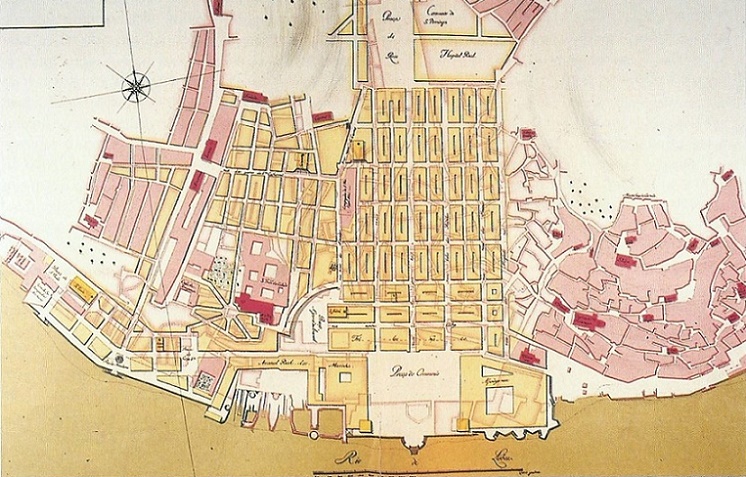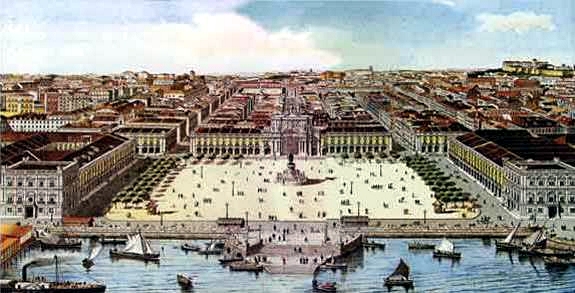Portugal Dec 28-Jan 8 2018
Flying always leaves one exhausted, but these are always long days: a healthy walk to the bus, a BC ferry from Nanaimo to Vancouver at 8:30, a flight at 23:30 on AirTransat ($458 one-way, a Quebec firm that has once/week flights to several places in Europe). Landed at London Gatwick, flew to Porto, Portugal and slept in the airport (see www.sleepinginairports.com). After a short flight to Lisbon, I stayed at a superb hostel, Travellers House, on Augusta, the main pedestrianized avenue in downtown Lisbon. Below the balcony was a constant parade of people and buskers.
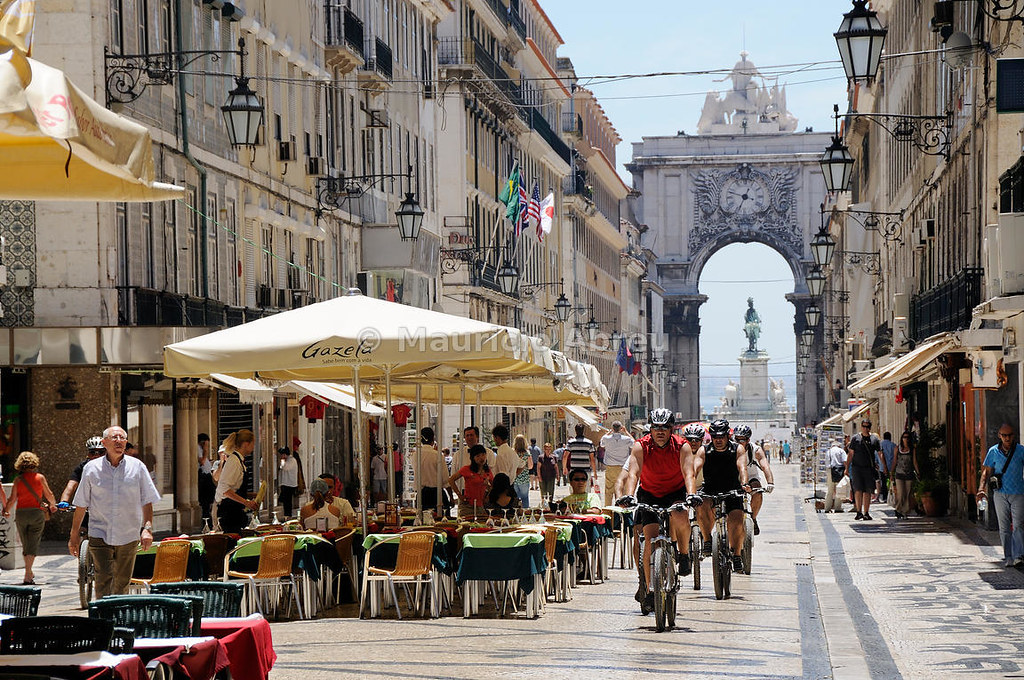
LISBON
Portuguese: Lisboa, is the capital and the largest city of Portugal, with a population of 552,700 in its borders but an urban population of around 2.7 million people (27% of the country’s population) making it the 11th-most populous urban area in the European Union. Its metro area forms the westernmost point of Continental Europe and the only one on the Atlantic coast. It lies on the River Tagus.
Lisbon is recognized as an alpha-level global city because of its importance in finance, commerce, media, entertainment, arts, international trade, education and tourism. It is one of the major economic centres on the continent, with a growing financial sector and one of the largest container ports on Europe’s Atlantic coast. In 2015, Humberto Delgado Airport served over 20 million passengers annually. The city is the 7th-most-visited city in Southern Europe, after Rome, Barcelona, Madrid, Athens and Milan, with 1,740,000 tourists in 2009. Most of the headquarters of multinationals in the country are located in the Lisbon area.
Lisbon is one of the oldest cities in the world, and the oldest in Western Europe, predating other modern European capitals such as London, Paris and Rome by centuries. Julius Caesar made it a municipium called Felicitas Julia, adding to the name Olissipo. Ruled by a series of Germanic tribes from the 5th century, it was captured by the Moors in the 8th century. In 1147, the Crusaders under Afonso Henriques reconquered the city and since then it has been a major political, economic and cultural centre of Portugal.
History.
Pre-Roman. Neolithic Pre-Celtic tribes, built religious and funerary monuments, megaliths, dolmens and menhirs. Iron Age people from the 8th to 6th centuries BC maintained commercial relations with the Phoenicians, present since 1200 BC. The sheltered harbour in the Tagus River estuary was an ideal spot for a settlement. Lusitanian horses were renowned in antiquity.
Roman era. Following the defeat of Hannibal during the Punic Wars, the Romans were determined to deprive Carthage of its most valuable possession: Hispania. It was integrated with the Roman province of Lusitania. Exempt from taxes, its citizens were given the privileges of Roman citizenship. They constructed a wall, a great theatre; the Cassian Baths (underneath Rua da Prata); temples and a large forum.
The city prospered as piracy was eliminated and it became a centre of trade with the Roman provinces of Britannia (particularly Cornwall) and the Rhine. Economically strong, Olissipo was known for its garum (a fish sauce highly prized by the elites of the empire and exported in amphorae to Rome), wine, salt and horse breeding. The city was connected by a broad road to Bracara Augusta (Portuguese Braga), and Emerita Augusta, the capital of Lusitania (Mérida, Spain). By the time of the Fall of Rome, Olissipo had become a notable Christian centre and there were barbarian invasions; between 409 and 429 the city was occupied successively by Sarmatians, Alans and Vandals. In 585, the Suebi Kingdom was integrated into the Germanic Visigothic Kingdom of Toledo, which comprised all of the Iberian Peninsula.
Middle Ages. On 6 August 711, Lisbon was taken by Muslim forces, mostly Berbers and Arabs from North Africa and the Middle East, who built many mosques and houses, rebuilt the city wall (known as the Cerca Moura) and established administrative control, while permitting the diverse population to maintain their socio-cultural lifestyles. The Muslim influence is still visible in the Alfama district.
In 1108 Lisbon was raided and occupied by Norwegian crusaders led by Sigurd I on their way to the Holy Land as part of the Norwegian Crusade and occupied by crusader forces for three years.
In 1147, as part of the Reconquista, crusader knights led by Afonso I of Portugal besieged and conquered Lisbon, then with 154,000 residents. Most Muslims fled to other parts of the Islamic world, primarily Muslim Spain and North Africa. All mosques were either destroyed or converted into churches. As a result of the end of Muslim rule, spoken Arabic quickly lost its place in the everyday life of the city and disappeared altogether.
With its central location, Lisbon became the capital city of the new Portuguese territory in 1255. The first Portuguese university was founded in Lisbon in 1290 by King Denis I. During the last centuries of the Middle Ages, the city expanded substantially and became an important trading post with both Northern European and Mediterranean cities.
Early Modern. Most of the Portuguese expeditions of the Age of Discovery left Lisbon during the period from the end of the 15th century to the beginning of the 17th century, including Vasco da Gama’s expedition to India in 1498.
In 1506, 3,000 Jews were massacred in Lisbon. The 16th century was Lisbon’s golden era: the city was the European hub of commerce between Africa, India, the Far East and later, Brazil, and acquired great riches by exploiting the trade in spices, slaves, sugar, textiles and other goods. This period saw the rise of the exuberant Manueline style in architecture, which left its mark in many 16th-century monuments (including Lisbon’s Belém Tower and Jerónimos Monastery, which were declared UNESCO World Heritage Sites).
Portugal lost its independence to Spain after the succession crisis of 1580, initiating sixty years of dual monarchy in Portugal and Spain under the Spanish Habsburgs and all three Spanish kings during that period were called Philip (Filipe). The Portuguese Restoration War, which began with a coup d’état organized by the nobility and bourgeoisie in Lisbon and executed on 1 December 1640, restored Portuguese independence. The 1668 Treaty of Lisbon finally brought peace.
In the early 18th century, gold from Brazil allowed King John V to sponsor the building of several Baroque churches and theatres in the city.
Prior to the 18th century, Lisbon had experienced several significant earthquakes – eight in the 14th century, five in the 16th century (including the 1531 earthquake that destroyed 1,500 houses and the 1597 earthquake in which three streets vanished), and three in the 17th century. On 1 November 1755, the city was destroyed by another devastating earthquake, which killed an estimated 30,000 to 40,000 Lisbon residents of a population estimated at between 200,000 and 275,000 and destroyed 85 percent of the city’s structures. Among several important buildings of the city, the Ribeira Palace and the Hospital Real de Todos os Santos were lost. In coastal areas, such as Peniche, situated about 80 km (50 mi) north of Lisbon, many people were killed by the following tsunami.
After the 1755 earthquake, the city was rebuilt largely according to the plans of Prime Minister Pombal; the lower town began to be known as the Baixa Pombalina. Instead of rebuilding the medieval town, Pombal decided to demolish what remained after the earthquake and rebuild the city centre following the principles of modern urban design. It was reconstructed in an open rectangular plan with two great squares: the Praça do Rossio and the Praça do Comércio. The first, the central commercial district, is the traditional gathering place of the city and the location of the older cafés, theatres and restaurants; the second became the city’s main access to the River Tagus and point of departure and arrival for seagoing vessels, adorned by a triumphal arch (1873) and a monument to King Joseph I.
Late modern and contemporary. In the first years of the 19th century, Portugal was invaded by the troops of Napoléon Bonaparte, forcing Queen Maria I and Prince-Regent John (future John VI) to flee temporarily to Brazil. By the time the new King returned to Lisbon, many of the buildings and properties were pillaged, sacked or destroyed by the invaders.
The city refounded its university in 1911 after centuries of inactivity and today there are two public universities in the city (the University of Lisbon and the New University of Lisbon) and a polytechnic institute.
During World War II, Lisbon was one of the very few neutral, open European Atlantic ports, a major gateway for refugees to the U.S. and a haven for spies. More than 100,000 refugees were able to flee Nazi Germany via Lisbon.
Lisbon was the site of three revolutions in the 20th century. The first, the 5 October 1910 revolution, brought an end to the Portuguese monarchy and established the highly unstable and corrupt Portuguese First Republic. The 6 June 1926 revolution began the Portuguese Second Republic, as the ruling regime. The final revolution, the Carnation Revolution on 25 April 1974 would end the right-wing Estado Novo and reform the country as the current Portuguese Third Republic.
In the 1990s, many of the districts were renovated and projects in the historic quarters were established to modernize those areas; architectural and patrimonial buildings were renovated; the northern margin of the Tagus was re-purposed for leisure and residential use; the Vasco da Gama Bridge was constructed; and the eastern part of the municipality was re-purposed for Expo ’98, to commemorate the 500th anniversary of Vasco da Gama’s sea voyage to India, a voyage that would bring immense riches to Lisbon and cause many of Lisbon’s landmarks to be built.
In 1988, a fire in the historical district of Chiado saw the destruction of many 18th-century Pombaline-style buildings. A series of restoration works has brought the area back to its former self and made it a high-scale shopping district.
In 1994, Lisbon was the European Capital of Culture. On 7 July 2007, Lisbon held the ceremony of the “New 7 Wonders Of The World” election. Every two years, Lisbon hosts the Rock in Rio Lisboa Music Festival, one of the largest in the world.
Geography
The westernmost part of Lisbon is occupied by the Parque Florestal de Monsanto (English: Monsanto Forest Park), a 10 km2 (4 sq. mi) urban park, one of the largest in Europe, and occupying ten percent of the municipality.
Climate. Lisbon has a Mediterranean climate with mild, rainy winters and warm to hot, dry summers. The average annual temperature is 21.3 °C (70.3 °F) during the day and 13.5 °C (56.3 °F) at night.
In the coldest month – January – the highest day temperature is 10 to 18 °C the lowest temperature at night ranges from 3 to 13 °C and the average sea temperature is 14 °C (57 °F). In the warmest month – August – the highest day temperature is 26 to 36 °C, the night temperature is 16 to 25 °C and the average sea temperature is 20 °C (68.
Among European cities with a population above 500,000, Lisbon has one of the warmest winters (less than Valencia or Málaga). The minimum temperature recorded in Lisbon was −1.2 °C (30 °F) in February 1956 and −1 °C (30 °F) in January 1985. The maximum temperature recorded in Lisbon was 42 °C (108 °F) on 1 August 2003.
Rain occurs mainly in winter, the summers being generally dry. Sunshine hours average 4.6 hours in December and 11.4 hours in July.
Bairros. Locally, Lisbon’s inhabitants may commonly refer to the spaces of Lisbon in terms of historic Bairros de Lisboa (neighbourhoods). These communities have no clearly defined boundaries and represent distinctive quarters of the city that have in common a historical culture, similar living standards, and identifiable architectural landmarks, as exemplified by the Bairro Alto, Alfama, Chiado, and so forth.
Alcântara. Although today it is quite central, it was once a mere suburb of Lisbon, comprising mostly farms and country estates of the nobility with their palaces. In the 16th century, there was a brook there which the nobles used to promenade in their boats. During the late 19th century, Alcântara became a popular industrial area, with lots of small factories and warehouses. In the early 1990s, Alcântara began to attract youth because of the number of pubs and discothèques. It became gentrified, attracting loft developments and new flats, which have profited from its river views and central location.
The riverfront of Alcântara is known for its clubs and bars. The area is commonly known as docas (docks), since most of the clubs and bars are housed in converted dock warehouses.
Alfama. The oldest district of Lisbon, it spreads down the southern slope from the Castle of São Jorge to the River Tagus. During the Islamic invasion of Iberia, the Alfama constituted the largest part of the city, extending west to the Baixa neighbourhood. Increasingly, the Alfama became inhabited by fishermen and the poor: its fame as a poor neighbourhood continues to this day. While the 1755 Lisbon earthquake caused considerable damage throughout the capital, the Alfama survived with little damage, thanks to its compact labyrinth of narrow streets and small squares.
It is a historical quarter of mixed-use buildings occupied by Fado bars, restaurants, and homes with small shops downstairs. Fado, the typically Portuguese style of melancholy music, is common in the restaurants of the district.
Mouraria. The Mouraria, or Moorish quarter, is one of the most traditional neighbourhoods of Lisbon, although most of its old buildings were demolished by the Estado Novo between the 1930s and the 1970s. It takes its name from the fact that after the reconquest of Lisbon, the Muslims who remained and Jews were confined to this part of the city.
Bairro Alto It functions as a residential, shopping and entertainment district; it is the centre of the Portuguese capital’s nightlife attracting Lisbon’s Punk, Gay, Metal, Goth, Hip Hop and Reggae scenes.
Baixa. The heart of the city is the Baixa or city centre; an elegant district, primarily constructed after the 1755 Lisbon earthquake. Pombal took the lead in rebuilding Lisbon, imposing strict conditions and guidelines on the construction of the city, and transforming the organic street plan that characterized the district before the earthquake into its current grid pattern.
As a result, the Pombaline Baixa is one of the first examples of earthquake-resistant construction. Architectural models were tested by having troops march around them to simulate an earthquake. Notable features of Pombaline structures include the Pombaline cage, an asymmetrical wood-lattice framework aimed at distributing earthquake forces, and inter-terrace walls that were built higher than roof timbers to inhibit the spread of fires.
Belém. Belém is famous as the place from which many of the great Portuguese explorers set off on their voyages of discovery: Vasco da Gama departed for India in 1497 and Pedro Álvares Cabral departed for Brazil in 1499.
It is also a former royal residence and features the 17th–18th century Belém Palace, a former royal residence now occupied by the President of Portugal, and the Ajuda Palace, begun in 1802 but never completed.
Perhaps Belém’s most famous feature is its tower, Torre de Belém, whose image is much used by Lisbon’s tourist board. The tower was built as a fortified lighthouse late in the reign of Dom Manuel l (1515–1520) to guard the entrance to the port. It stood on a little island on the right side of the Tagus, surrounded by water.
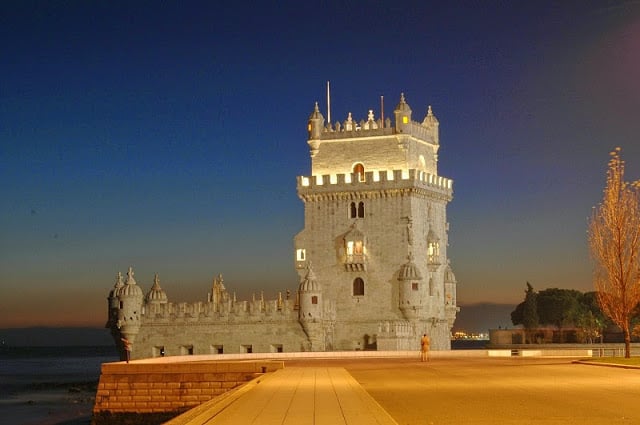
Belém’s other major historical building is the Mosteiro dos Jerónimos (Jerónimos Monastery), which the Torre de Belém was built partly to defend.
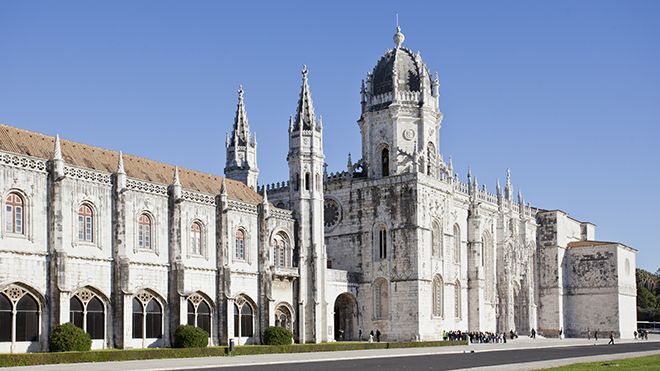
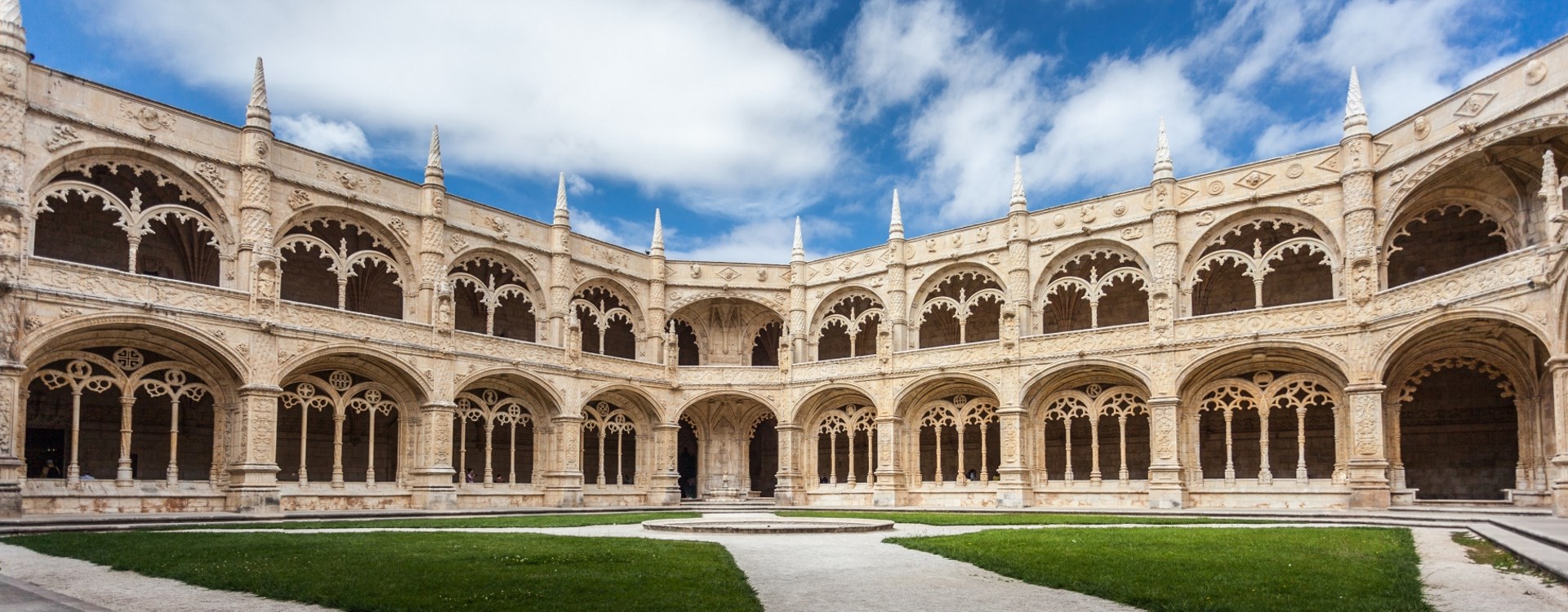
Belém’s most notable modern feature is the Padrão dos Descobrimentos (Monument to the Discoveries) built for the Portuguese World Fair in 1940.
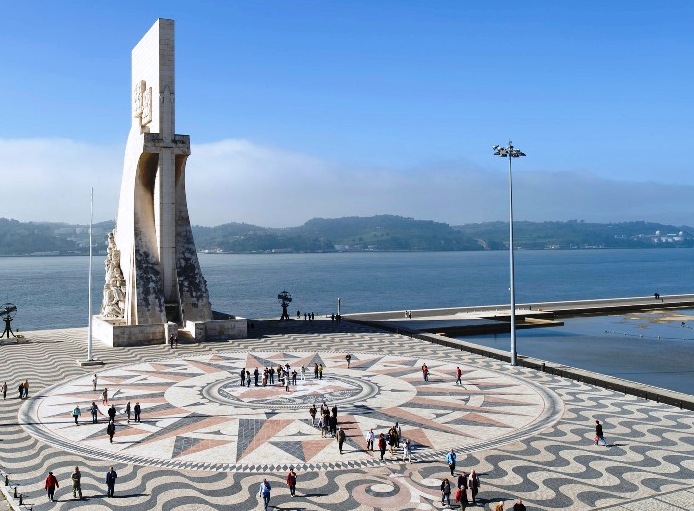

In the heart of Belém is the Praça do Império: gardens centred upon a large fountain, laid out during World War II. Belém is one of the most visited Lisbon districts.
Chiado. The Chiado is a traditional shopping area that mixes old and modern commercial establishments, concentrated especially in the Rua do Carmo and the Rua Garrett. Locals, as well as tourists, visit the Chiado to buy books, clothing and pottery as well as to have a cup of coffee. The Chiado is also an important cultural area, with several museums and theatres, including the opera. Several buildings of the Chiado were destroyed in a fire in 1988, an event that deeply shocked the country. Thanks to a renovation project that lasted more than 10 years, coordinated by celebrated architect Siza Vieira, the affected area has now virtually recovered.
The ornate, late 18th-century Estrela Basilica is the main attraction of this district. The church with its large dome is located on a hill in what was at the time the western part of Lisbon and can be seen from great distances. The style is similar to that of the Mafra National Palace, late baroque and neoclassical.
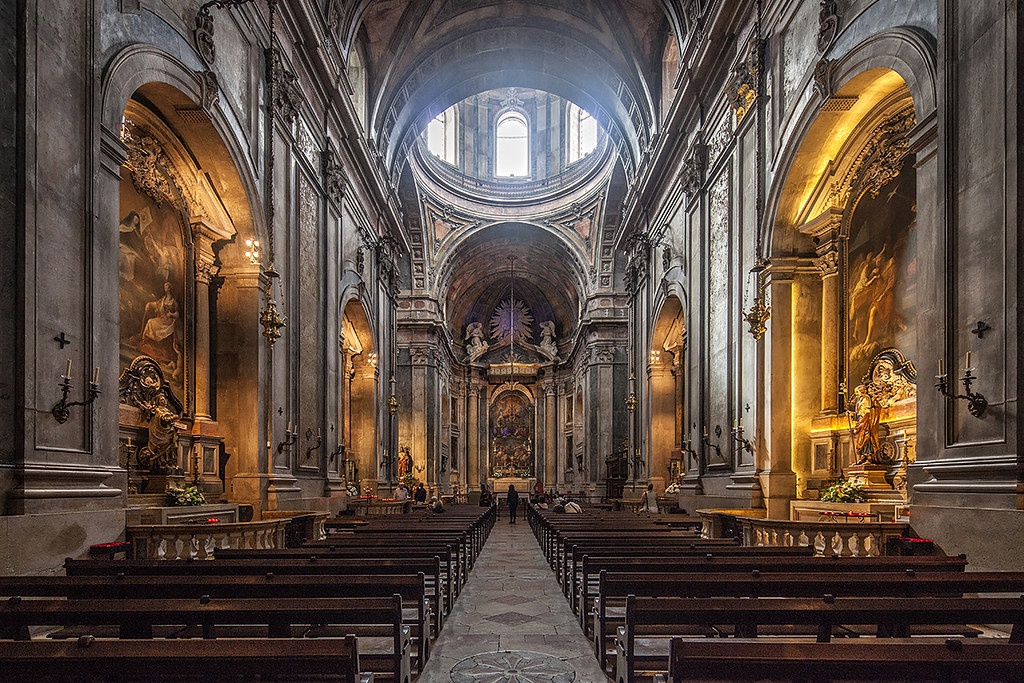
The façade has twin bell towers and includes statues of saints and some allegorical figures. São Bento Palace, the seat of the Portuguese parliament and the official residences of the Prime Minister of Portugal and the President of the Assembly of the Republic of Portugal are in this district. Also in this district is Estrela Park, a favourite with families. There are exotic plants and trees, a duck pond, various sculptures, a children’s playground, and many cultural events going on throughout the year, including outdoor cinema, markets, and music festivals.
Parque das Nações (Park of Nations) is the newest district in Lisbon, having emerged from an urban renewal programme leading to the World Exhibition of Lisbon 1998, also known as Expo’98. The area suffered massive changes giving Parque das Nações a futuristic look. A long-lasting legacy of the same, the area has become another commercial and higher-end residential area for the city. Central to this is the Gare do Oriente (Orient railway station), one of the main transport hubs of Lisbon for trains, buses, taxis and the metro. Its glass and steel columns are inspired by Gothic architecture, lending the whole structure a visual fascination (especially in sunlight or when illuminated at night). Across the street, through Vasco da Gama Mall, is Parque das Nações (Park of the Nations), site of the 1998 World Expo.
The area is pedestrian-friendly with new buildings, restaurants, gardens, the Casino Lisbon, the FIL building (International Exhibition and Fair), the Camões Theatre, as well as the Oceanário de Lisboa (Lisbon Oceanarium), the second largest in the world. The district’s MEO Arena has become Lisbon’s “jack-of-all-trades” performance arena. Seating 20,000, it has staged events from concerts to basketball tournaments.
Culture. The city of Lisbon is rich in architecture: Romanesque-Gothic, Manueline, Baroque, Modern and Postmodern constructions can be found all over Lisbon. The city is also crossed by historical boulevards and monuments along the main thoroughfares, particularly in the upper districts; notable among these are the Avenida da Liberdade (Avenue of Liberty), Avenida Fontes Pereira de Melo, Avenida Almirante Reis and Avenida da República (Avenue of the Republic).
There are several substantial museums in the city. The most famous ones are the Museu Nacional de Arte Antiga (National Museum of Ancient Art), the National Azulejo Museum, the Museu Calouste Gulbenkian (Calouste Gulbenkian Museum), containing varied collections of ancient and modern art, the Museu Nacional do Traje e da Moda (National Museum of Costume and Fashion), the Berardo Collection Museum (Modern Art) at the Belém Cultural Centre, the Museu da Electricidade (Electricity Museum), the Museu Nacional dos Coches (National Coach Museum, containing the largest collection of royal coaches in the world), the National Museum of Natural History and Science, Museum of the Orient, and the Lisbon City Museum.
Lisbon’s Opera House, the Teatro Nacional de São Carlos, hosts a relatively active cultural agenda, mainly in autumn and winter. Maria II National Theatre, located in Rossio Square, is one of Portugal’s most prestigious venues.
The monument to Christ the King (Cristo-Rei) stands on the southern bank of the Tagus River, in Almada. With open arms, overlooking the whole city, it resembles the Corcovado monument in Rio de Janeiro and was built after World War II, as a memorial of thanksgiving for Portugal’s being spared the horrors and destruction of the war.
13 June is Lisbon´s holiday in honour of the city’s saint, Anthony of Lisbon. Saint Anthony, also known as Saint Anthony of Padua, was a wealthy Portuguese bohemian who was canonized and made Doctor of the Church after a life preaching to the poor. Although Lisbon’s patron saint is Saint Vincent of Saragossa, whose remains are housed in the Sé Cathedral, there are no festivities associated with this saint.
The National Coach Museum has the largest collection of royal carriages in the world and is one of Lisbon’s most visited institutions.
Eduardo VII Park, the second-largest park in the city following the Parque Florestal de Monsanto (Monsanto Forest Park), extends down the main avenue (Avenida da Liberdade), with many flowering plants and green spaces, that includes the permanent collection of subtropical and tropical plants in the winter garden (Portuguese: Estufa Fria). Originally named Parque da Liberdade, it was renamed in honour of Edward VII of England who visited Lisbon in 1903.
Lisbon is home every year to the Lisbon Gay & Lesbian Film Festival, the Lisboarte, the DocLisboa – Lisbon International Documentary Film Festival, the Festival Internacional de Máscaras e Comediantes, the Lisboa Mágica – Street Magic World Festival, the Monstra – Animated Film Festival, the Lisbon Book Fair, the Peixe em Lisboa – Lisbon Fish and Flavours, and many others.
Lisbon has two sites listed by UNESCO as a World Heritage Site: Belém Tower and Jerónimos Monastery. The Calouste Gulbenkian Foundation is one of the wealthiest foundations in the world and houses one of the largest private collections of antiquaries and art in the world, within the Gulbenkian Museum.
In addition, the mosaic Portuguese pavement (Calçada Portuguesa) was born in Lisbon, in the mid-1800s. The art has since spread to the rest of the Portuguese Speaking World. The city remains one of the most expansive examples of the technique, with nearly all walkways and even many streets being created and maintained in this style.
Economy. The Port of Lisbon is one of the busiest in Europe. The Lisbon region is the wealthiest in Portugal and it is well above the European Union’s GDP per capita average – it produces 45% of the Portuguese GDP. Lisbon’s economy is based primarily on the tertiary sector. Most of the headquarters of multinationals operating in Portugal are concentrated in the Grande Lisboa Subregion, especially in the Oeiras municipality. The Lisbon Metropolitan Area is heavily industrialized, especially the south bank of the Tagus River (Rio Tejo). The Lisbon region is rapidly growing.
The country’s chief seaport, featuring one of the largest and most sophisticated regional markets on the Iberian Peninsula, Lisbon and its heavily populated surroundings are also developing as an important financial centre and a dynamic technological hub. Automobile manufacturers have erected factories in the suburbs, for example, AutoEuropa. The Lisbonite industry has very large sectors in oil, as refineries are found just across the Tagus, textile mills, shipyards and fishing.
Before Portugal’s sovereign debt crisis and an EU-IMF rescue plan, for the decade of 2010, Lisbon was expecting to receive many state-funded investments, including building a new airport, a new bridge, an expansion of 30 km (18.64 mi) underground, the construction of a mega-hospital (or central hospital), the creation of two lines of a TGV to join Madrid, Porto, Vigo and the rest of Europe, the restoration of the main part of the town (between the Marquês de Pombal roundabout and Terreiro do Paço), the creation of a large number of bike lanes, as well as modernization and renovation of various facilities.
Transport. The Lisbon Metro is its main artery, connecting the city centre with the upper and eastern districts and now reaching the suburbs. Several expansion projects have been proposed.
Trams. A traditional form of public transport in Lisbon is the tram. Introduced in the 19th century, the trams were originally imported from the USA and called the americanos. The earliest trams can still be seen in the Museu da Carris (the Public Transport Museum). Other than on the modern Line 15, the Lisbon tramway system still employs small (four-wheel) vehicles of a design dating from the early twentieth century. These distinctive yellow trams are one of the tourist icons of modern Lisbon, and their size is well suited to the steep hills and narrow streets of the central city.
Trains. Four commuter train lines depart from Lisbon: the Cascais, Sintra and Azambuja lines (operated by CP – Comboios de Portugal), as well as a fourth line to Setúbal (operated by Fertagus) crossing the Tagus river, over the 25 de Abril Bridge. The major railway stations are Santa Apolónia, Rossio, Gare do Oriente, Entrecampos, and Cais do Sodré.
Buses. There are other commuter bus services from the city (connecting cities outside Lisbon and connecting these cities to Lisbon): Vimeca, Rodoviária de Lisboa, Transportes Sul do Tejo, Boa Viagem, Barraqueiro are the main ones, operating from different terminals in the city.
Bridges and ferries. The city is connected to the far side of the Tagus by two important bridges: The 25 de Abril Bridge, inaugurated in 1966, was the longest suspension bridge in Europe. The Vasco da Gama Bridge, inaugurated in 1998 is, at 17.2 km (10.7 mi), the longest bridge in Europe.
Another way of crossing the river is by taking the ferry that operates from different points in the city to Cacilhas, Seixal, Montijo, Porto Brandão and Trafaria under the brand Transtejo and to Barreiro under the brand Soflusa.
Air travel. Humberto Delgado Airport is located within the city limits. It is the headquarters and hub for TAP Portugal as well as a hub for Easyjet, Azores Airlines, Ryanair, EuroAtlantic Airways, White Airways, and Hi Fly. A second airport has been proposed, but the project has been put on hold because of the Portuguese and European economic crisis, and also because of the long discussion on whether a new airport is needed.
PORTO
Porto also known as Oporto in English is the second-largest city in Portugal after Lisbon. The urban area of Porto has a population of 2.4 million (2011) in an area of 389 km2 (150 sq. mi) and is the only Portuguese city besides Lisbon to be recognized as a global city.
Located along the Douro River estuary in Northern Portugal, Porto is one of the oldest European centres, and its historical core was proclaimed a World Heritage Site by UNESCO in 1996. Its settlement dates back many centuries when it was an outpost of the Roman Empire. Its combined Celtic-Latin name, Portus Cale, has been referred to as the origin of the name “Portugal”, based on transliteration and oral evolution from Latin.
One of Portugal’s internationally famous exports, port wine, is named after Porto, since the metropolitan area, and in particular, the cellars of Vila Nova de Gaia, were responsible for the packaging, transport and export of the fortified wine. In 2014 and 2017, Porto was elected The Best European Destination by the Best European Destinations Agency. Porto is on the Portuguese Way path of the Camino de Santiago.
History. The history of Porto dates back to around 300 BC with Celtic people being the first known inhabitants. Ruins of that period have been discovered in several areas. During the Roman occupation of the Iberian Peninsula, the city developed as an important commercial port, primarily in the trade between Olissipona (the modern Lisbon) and Bracara Augusta (the modern Braga).
Porto fell under the control of the Moors during the invasion of the Iberian Peninsula in 711. In 868, Vímara Peres, a warlord from Gallaecia, and a vassal of the King of Asturias, Léon and Galicia, Alfonso III, was sent to reconquer and secure the lands from the Moors. This included the area from the Minho to the Douro River: the settlement of Portus Cale and the area that is known as Vila Nova de Gaia. Portus Cale, later referred to as Portucale, was the origin of the modern name of Portugal. In 868, Count Vímara Peres established the County of Portugal.
In 1387, Porto was the site of the marriage of John I of Portugal and Philippa of Lancaster, daughter of John of Gaunt; this symbolized a long-standing military alliance between Portugal and England. The Portuguese-English alliance (Treaty of Windsor) is the world’s oldest recorded military alliance, which inspired the formation of NATO.
In the 14th and 15th centuries, Porto’s shipyards contributed to the development of Portuguese shipbuilding. It was also from the port of Porto that, in 1415, Prince Henry the Navigator (son of John I of Portugal) embarked on the conquest of the Moorish port of Ceuta, in northern Morocco. This expedition by the King and his fleet, which counted among others Prince Henry, was followed by navigation and exploration along the western coast of Africa, initiating the Portuguese Age of Discovery. The nickname given to the people of Porto began in those days; Portuenses are to this day, colloquially, referred to as tripeiros (English: tripe peoples), referring to this period of history, when higher-quality cuts of meat were shipped from Porto with their sailors, while off-cuts and by-products, such as tripe, were left behind for the citizens of Porto: tripe remains a culturally important dish in modern-day Porto.
18th century. Wine, produced in the Douro valley, was already in the 13th century transported to Porto in barcos rabelos (flat sailing vessels). In 1703, the Methuen Treaty established trade relations between Portugal and England. In 1717, the first English trading post was established in Porto. The production of port wine then gradually passed into the hands of a few English firms. To counter this English dominance, Prime Minister Marquis of Pombal established a Portuguese firm receiving the monopoly of the wines from the Douro valley. He demarcated the region for the production of port, to ensure the wine’s quality; this was the first attempt to control wine quality and production in Europe. The small winegrowers revolted against his strict policies on Shrove Tuesday, burning down the buildings of this firm. The revolt was called Revolta dos Borrachos (revolt of the drunks).
Between 1732 and 1763, Italian architect Nicolau Nasoni designed a baroque church with a tower that became its architectural and visual icon: the Torre dos Clérigos (English: Clerics’ Tower). During the 18th and 19th centuries, the city became an important industrial centre and saw its size and population increase.
19th century. The invasion of the Napoleonic troops in Portugal under Marshal Soult also brought war to the city of Porto. On 29 March 1809, as the population fled from the advancing French troops and tried to cross the river Douro over the Ponte das Barcas (a pontoon bridge), the bridge collapsed under the weight. This event is still remembered by a plate at the Ponte D. Luis I. The French army was rooted out of Porto by Arthur Wellesley, 1st Duke of Wellington, when his Anglo-Portuguese Army crossed the Douro river from the Mosteiro da Serra do Pilar (a former convent) in a brilliant daylight coup de main, using wine barges to transport the troops, so outflanking the French Army.
On 24 August 1820, a liberal revolution occurred, quickly spreading without resistance to the rest of the country. In 1822, a liberal constitution was accepted, partly through the efforts of the liberal assembly of Porto (Junta do Porto). When Miguel I of Portugal took the Portuguese throne in 1828, he rejected this constitution and reigned as an absolutist monarch. A Civil War was then fought from 1828 to 1834 between those supporting Constitutionalism, and those opposed to this change, keen on near-absolutism and led by D. Miguel. Porto rebelled again and had to undergo a siege of eighteen months between 1832 and 1833 by the absolutist army. Porto is also called “Cidade Invicta” (English: Unvanquished City) after successfully resisting the Miguelist siege. After the abdication of King Miguel, the liberal constitution was re-established.
Known as the city of bridges, Porto built its first permanent bridge, the Ponte das Barcas (a pontoon bridge), in 1806. Three years later, it collapsed under the weight of thousands of fugitives from the French Invasions during the Peninsular War, causing thousands of deaths. It was replaced by the Ponte D. Maria II, popularised under the name Ponte Pênsil (suspended bridge) and built between 1841 43; only its supporting pylons have remained.
The Ponte D. Maria, a railway bridge, was inaugurated on 4 November of that same year; it was considered a feat of wrought iron engineering and was designed by Gustave Eiffel, notable for his Parisian tower. The later Ponte Dom Luís I replaced the aforementioned Ponte Pênsil. This last bridge was made by Teophile Seyrig, a former partner of Eiffel. Seyrig won a governmental competition that took place in 1879. Building began in 1881 and the bridge was opened to the public on 31 October 1886.
Unrest by Republicans led to the first revolt against the monarchy in Porto on 31 January 1891. This resulted ultimately in the overthrow of the monarchy and proclamation of the republic by the 5 October 1910 revolution.
20th century. On 19 January 1919, forces favourable to the restoration of the Monarchy launched in Porto a counter-revolution known as Monarchy of the North. During this time, Porto was the capital of the restored kingdom, as the movement was contained to the north. The monarchy was deposed less than a month later and no other monarchist revolution in Portugal happened again.
The historic centre of Porto was declared a World Heritage Site by UNESCO in 1996. The World Heritage site is defined in two concentric zones; the “Protected area”, and within it the “Classified area”. The Classified area comprises the medieval borough located inside the 14th-century Romanesque wall.
Geography. Among the architectural highlights of the city, Porto Cathedral is the oldest surviving structure, together with the small Romanesque Church of Cedofeita, the gothic Igreja de São Francisco (Church of Saint Francis), the remnants of the city walls and a few 15th-century houses. The baroque style is well represented in the city in the elaborate gilt work interior decoration of the churches of St. Francis and St. Claire (Santa Clara), the churches of Mercy (Misericórdia) and of the Clerics (Igreja dos Clérigos), the Episcopal Palace of Porto, and others. The neoclassicism and romanticism of the 19th and 20th centuries also added interesting monuments to the landscape of the city, like the magnificent Stock Exchange Palace (Palácio da Bolsa), the Hospital of Saint Anthony, the Municipality, the buildings in the Liberdade Square and the Avenida dos Aliados, the tile-adorned São Bento Train Station and the gardens of the Crystal Palace (Palácio de Cristal). A guided visit to the Palácio da Bolsa, and in particular the Arab Room, is a major tourist attraction.
Many of the city’s oldest houses are at risk of collapsing. The population in Porto municipality dropped by nearly 100,000 since the 1980s, but the number of permanent residents in the outskirts and satellite towns has grown strongly.
Climate. Porto features a warm-summer Mediterranean climate. As a result, its climate shares many characteristics with the coastal south: warm, dry summers and mild, rainy winters. Occasional summer rainy periods may last a few days in the afternoon. The annual precipitation is high and concentrated in the winter months, making Porto one of the wettest major cities of Europe. However, long periods with mild temperatures and sunny days are frequent even during the rainiest months.
Summers are typically sunny with average temperatures between 16 °C (61 °F) and 27 °C (81 °F) but can rise to as high as 38 °C (100 °F) during occasional heat waves. During such heat waves, the humidity remains quite low. Nearby beaches are often windy and usually cooler than the urban areas. Porto is noticeably sunnier than Barcelona and Rome, both on the same latitude.
Winter temperatures typically range between 5 °C (41 °F) during morning and 15 °C (59 °F) in the afternoon but rarely drop below 0 °C (32 °F) at night. The weather is often rainy for long stretches although prolonged sunny periods do occur.
Economy. As the most important city in the heavily industrialized northwest, many of the largest Portuguese corporations from diverse economic sectors, like Altri, Ambar, Amorim, Bial, Cerealis, BPI, CIN, EFACEC, Frulact, Lactogal, Millennium, Porto Editora, Grupo RAR, Sonae, Sonae Indústria, and Unicer, are headquartered in the Greater Metropolitan Area of Porto, most notably, in the core municipalities of Maia, Matosinhos, Porto, and Vila Nova de Gaia. The country’s biggest exporter (Petrogal) has one of its two refineries near the city.
The building formerly hosting the former stock exchange is currently one of the city’s touristic attractions, the Salão Árabe (Arab Room in English) being its major highlight.
The economic relations between the city of Porto and the Upper Douro River have been documented since the Middle Ages. However, they were greatly deepened in the modern age. Indeed, sumach, dry fruits and nuts and the Douro olive oils sustained prosperous exchanges between the region and Porto. From the riverside quays at the river mouth, these products were exported to other markets of the Old and New World.
Transport. Porto is often referred to as Cidade das Pontes (City of the Bridges), besides its more traditional nicknames of “Cidade Invicta” (Unconquered/ Invincible City) and “Capital do Norte” (Capital of the North).
Airports. Porto is served by Francisco de Sá Carneiro Airport 15 kilometres (9 miles) to the northwest of the city centre.
Railways. Porto’s main railway station is situated in Campanhã, located in the eastern part of the city. From here, both light rail and suburban rail services connect to the city centre. The main central station is São Bento Station, which is itself a notable landmark located in the heart of Porto.
Subway and light rail. Currently, the major project is the Porto Metro, a light rail system and six lines. Currently, the whole network spans 60 km (37 mi) using 68 stations, thus being the biggest metro system in the country.
Bus. A bus journey is 1.85 Euro, which must be paid in cash.
Trams. A tram network, of which only three lines remain one of them being a tourist line on the shores of the Douro, saw its construction begin in 1895.
Culture. In 2001, Porto shared the designation European Culture Capital. In the scope of these events, the construction of the major concert hall space Casa da Música, was initiated and finished in 2005.
Porto has several museums, concert halls, theatres, cinemas, art galleries, libraries and bookshops. The best-known museums of Porto are the National Museum Soares dos Reis (Museu Nacional de Soares dos Reis), which is dedicated especially to the Portuguese artistic movements from the 16th to the 20th century, and the Museum of Contemporary Art of the Serradlves Foundation (Museu de Arte Contemporânea). The city has concert halls of rare beauty and elegance such as the Coliseu do Porto by the Portuguese architect Cassiano Branco; an exquisite example of the Portuguese decorative arts. Other notable venues include the historical São João National Theatre, the Rivolit theatre, the Batalha cinema and Casa da Música, inaugurated in 2005. The city has the Lello Bookshop, which is frequently rated among the top bookstores in the world.
Porto houses the largest synagogue in the Iberian Peninsula and one of the largest in Europe – Kadoorie Synagogue, inaugurated in 1938.
Entertainment. Porto’s most popular event is St. John (São João Festival) on the night of 23–24 June. In this season it’s a tradition to have a vase with bush basil decorated with a small poem. During the dinner of the great day, people usually eat sardines and boiled potatoes together with red wine.
Another major event is Queima das Fitas, which starts on the first Sunday of May and ends on the second Sunday of the month. Basically, before the beginning of the study period preceding the school year’s last exams, academia tries to have as much fun as possible. The week has 12 major events, starting with the Monumental Serenata on Sunday, and reaching its peak with the Cortejo Académico on Tuesday when about 50,000 students of the city’s higher education institutions march through the downtown streets till they reach the city hall. During every night of the week, a series of concerts takes place on the Queimódromo, next to the city’s park, where it’s also a tradition for the students in their second-to-last year to erect small tents where alcohol is sold to finance the trip that takes place during the last year of their course of study; an average of 50,000 students attend these shows.
Porto was considered the fourth-best value destination for 2012, by Lonely Planet.
Porto – My Experience. I took the train from Lisbon to Porto (3 hours, 22 €) changing to the Sao Benito train station in the old part of town. This is a spectacular station – huge painted tile dioramas of daily life, kings and battles.

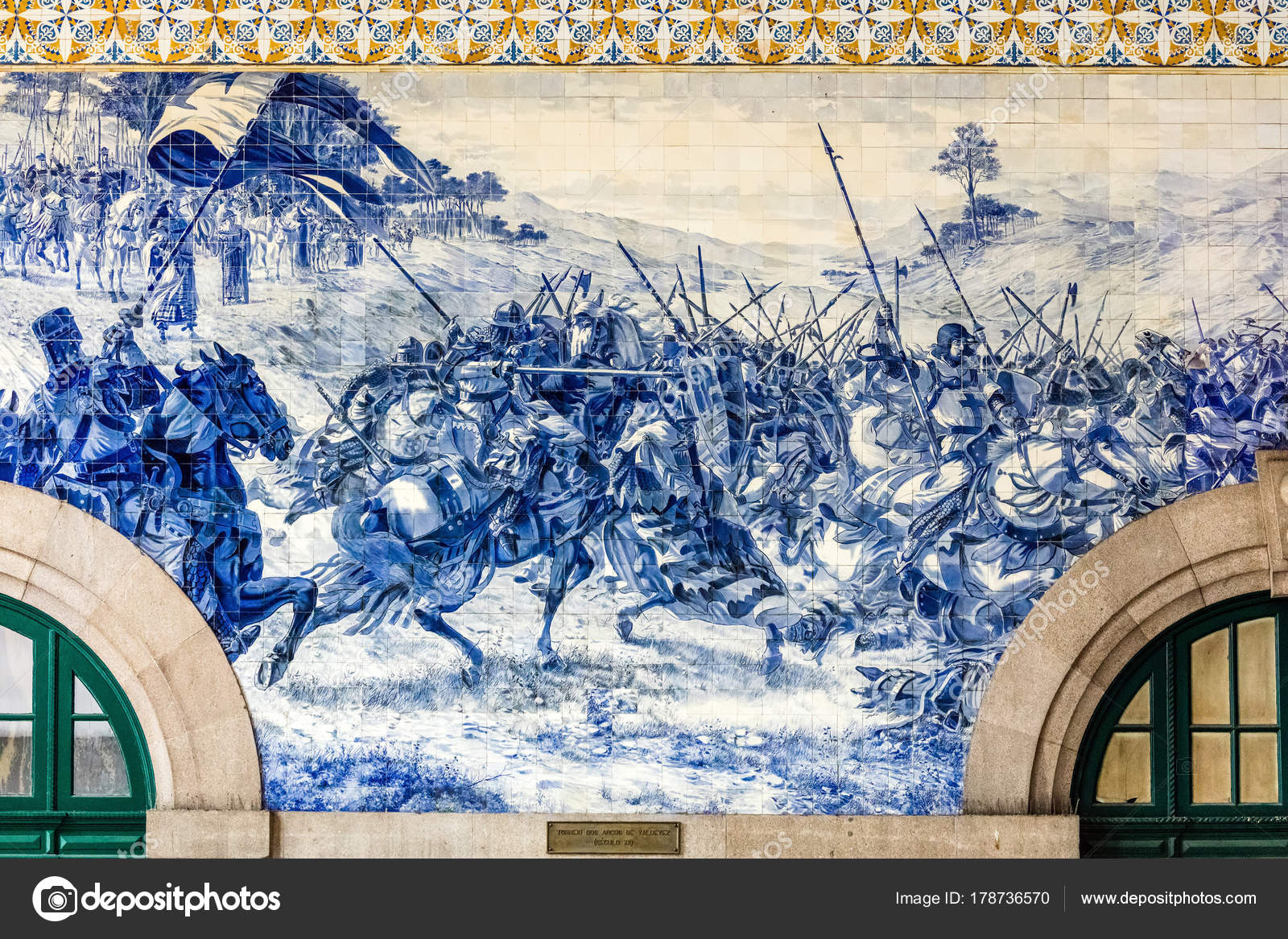
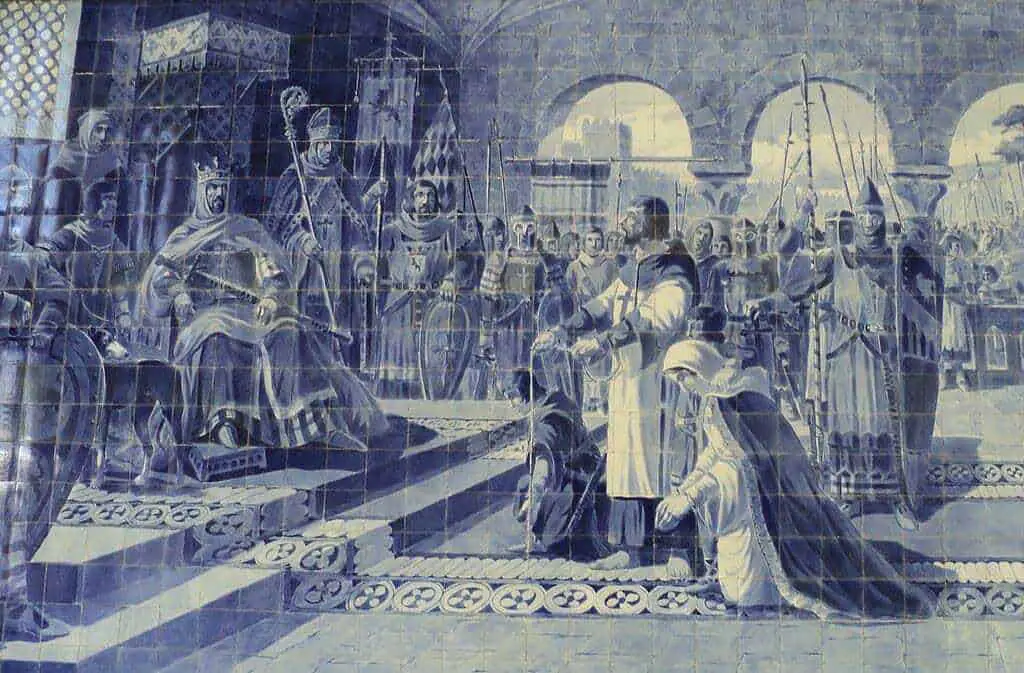
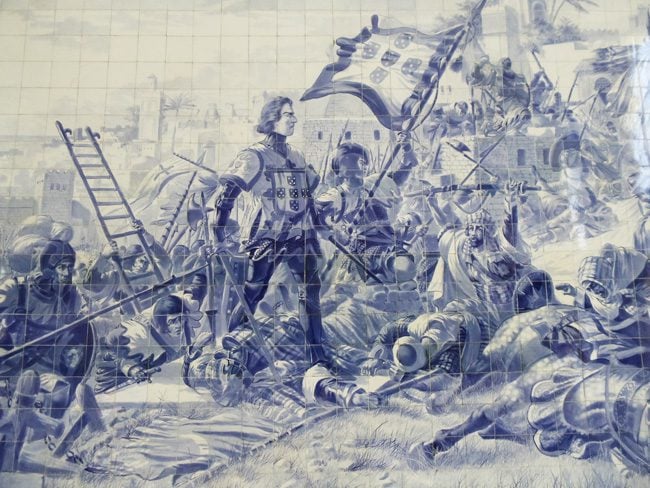
I stayed at Yes Hostel, next to the Tower. Arriving on Dec 31, I got to witness the huge New Year’s party that has become a Porto tradition for the last 5 years. After seeing the nice fireworks at midnight, I went to sleep and went out at 5 to see the party still in full swing.
The broken glass and garbage covered the entire old town. Amazingly it was all cleaned up by noon by an army of guys with rakes, brooms and air blowers. They know what to expect.
I went to the two walking tours offered by Porto Walkers. They meet at the big statue on the main square at 10:30 and 3:20. Both tours last 3-4 hours, charge by donation and are excellent. The first sees the lower part of the old town and the second explores more up the hill. One of the more surprising things was the flood levels marked on the walls down by the river, regularly flooded but not since 1996 when the mark was 10 feet up the wall. Marks from the ’60s were higher than that. A dam has been constructed and there has been none since.
It may be hard to believe, but by far the busiest business in Porto is McDonald’s. I have never seen one so crowded throughout the entire day. It took 20 minutes just to order and then it was standing room only. This one “restaurant” does more business than all the restaurants in the old town combined.
Some Observations on Portugal.
1. Portuguese are not very friendly people. They rarely smile and pilgrims are not high on their favourite list. I was refused service a few times because I was a Peregrino.
2. Like most southern Europeans (Spanish, Italian, Greek) and unlike almost all other Europeans, few speak English. This must be one factor in the economic problems of these countries. How can they compete on a world economic stage where English is the language of business?
3. You don’t want to argue with a Portuguese woman. They are hard-assed and never give up. I am used to people working in service industries who cater to their guests.


